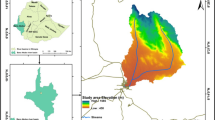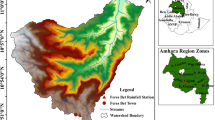Abstract
This paper examines the soil loss spatial patterns in the Keiskamma catchment using the GIS-based Sediment Assessment Tool for Effective Erosion Control (SATEEC) to assess the soil erosion risk of the catchment. SATEEC estimates soil loss and sediment yield within river catchments using the Revised Universal Soil Loss Equation (RUSLE) and a spatially distributed sediment delivery ratio. Vegetation cover in protected areas has a significant effect in curtailing soil loss. The effect of rainfall was noted as two pronged, higher rainfall amounts received in the escarpment promote vegetation growth and vigour in the Amatole mountain range which in turn positively provides a protective cover to shield the soil from soil loss. The negative aspect of high rainfall is that it increases the rainfall erosivity. The Keiskamma catchment is predisposed to excessive rates of soil loss due to high soil erodibility, steep slopes, poor conservation practices and low vegetation cover. This soil erosion risk assessment shows that 35% of the catchment is prone to high to extremely high soil losses higher than 25 ton ha−1 year−1 whilst 65% still experience very low to moderate levels of soil loss of less than 25 ton ha−1 year−1. Object based classification highlighted the occurrence of enriched valley infill which flourishes in sediment laden ephemeral stream channels. This occurrence increases gully erosion due to overgrazing within ephemeral stream channels. Measures to curb further degradation in the catchment should thrive to strengthen the role of local institutions in controlling conservation practice.











Similar content being viewed by others
References
Angima SD, Stott DE, O’Neill MK, Ong CK, Weesies GA (2003) Soil erosion prediction using RUSLE for central Kenyan highland conditions. Agric Ecosyst Environ 97:295–308
Arnold JG, Srinivasan R, Muttiah RS, Williams JR (1998) Large area hydrologic modeling and assessment part I: model development. J Am Water Resour Assoc 34(1):73–89
Bartsch KP, van Miegroet H, Boettinger J, Dobrwolski JP (2002) Using empirical erosion models and GIS to determine erosion risk at Camp Williams. J Soil Water Conserv 57:29–37
Benkobi L, Trlica MJ, Smith JL (1994) Evaluation of a refined surface cover subfactor for use in RUSLE. J Range Manag 47:74–78
Bennett J, Barrett H (2007) Rangeland as a common property resource: contrasting insights from communal areas of central eastern Cape Province, South Africa. Hum Ecol 35:97–112
Bhattarai R, Dutta D (2007) Estimation of soil erosion and sediment yield using GIS at catchment scale. Water Resour Manag 21:1635–1647
Biesemans J, Meirvenne MV, Gabriels D (2000) Extending the RUSLE with the Monte Carlo error propagation technique to predict long-term average off-site sediment accumulation. J Soil Water Conserv 55:35–42
Boggs G, Devonport C, Evans K, Puig P (2001) GIS-based rapid assessment of erosion risk in a small catchment in the wet/dry tropics of Australia. Land Degrad Dev 12:417–434
Congalton RG, Green K (1999) Assessing the accuracy of remotely sensed data: principles and practice. Lweis Publishers, Boca Raton
D’Huyvetter JHH (1985) Determination of threshold slope percentages for the identification and delineation of arable land in Ciskei. M.Sc. Thesis. University of Fort Hare
Definiens (2009) Definiens Developer 7: user guide. Definiens AG, München
Dennis MF, Rorke MF (1999) The relationship of soil loss by interill erosion to slope gradient. Catena 38:211–222
Desmet PJJ, Gover G (1997) Two-dimensional modelling of the within-field variation in rill and gully geometry and location related to topography. Catena 29(3–4):283–306
Desmet PJJ, Govers G (1996) A GIS-procedure for automatically calculating the USLE LS-factor on topographically complex landscape units. J Soil Water Conserv 51(5):427–433
DWAF (2004) Amatole-Kei area internal strategic perspective WMA 12. Report. 04 August 2004
Flanagan DC, Nearing MA (1995) USDA water erosion prediction project: hillslope profile and watershed model documentation. USDA-ARS National Soil Erosion Research Laboratory, West Lafayette
Flügel WA, Märker M, Moretti S, Rodolfi G (2003) Integrating GIS, remote sensing, ground truthing and modelling approaches for regional erosion classification of semiarid catchments in South Africa and Swaziland. Hydrol Process 17:917–928
Fu BJ, Zhao WW, Chen LD, Zhang QJ, Lü YH, Gulinck H, Poesen J (2005) assessment of soil erosion at large watershed scale using RUSLE and GIS: a case study in the Loess Plateau of China. Land Degrad Dev 16:7
Garland GG, Hoffman MT, Tod S (2000) Soil degradation. In: Hoffman MT, Todd S, Ntshona Z and Turner S (eds) A national review of land degradation in South Africa. South African National Biodiversity Institute, Pretoria, South Africa, pp 69–107. http://www.nbi.ac.za/landdeg
Hensley M, Laker MC (1975). Land resources of the Ciskei. In: The agricultural potential of the Ciskei—a preliminary report. University of Fort Hare, Alice
Hensley M, Laker MC (1978) Land resources of the consolidated Ciskei. In: The agricultural potential of the Ciskei. University of Fort Hare, Alice
Hui L, Xiaoling C, Lim KJ, Xiaobin J, Sagong M (2010) Assessment of soil erosion and sediment yield in Liao watershed, Jiangxi Province, China, Using USLE, GIS, and RS. J Earth Sci 21(6):941–953
Jenness J, Wynne JJ (2005) Cohen’s Kappa and classification table metrics 2.0: an ArcView 3x extension for accuracy assessment of spatially explicit models: U.S. Geological Survey Open-File Report OF 2005-1363. USGS
Kinnell PIA (2000) The effect of slope length on sediment concentrations associated with side-slope erosion. Soil Sci Soc Am J 64:1004–1008
Laker MC (1978) The agricultural potential of the Ciskei. Amended report. University of Fort Hare, Alice
Lal R (1994) Soil erosion by wind and water: problems and prospects. In: Lal R (ed) Soil erosion research methods, 2nd edn. Soil and Water Conservation Society, St. Lucie Press, pp 1–9
Lal R (1998) Soil erosion impact on agronomic productivity and environment quality: critical reviews. Plant Sci 17:319–464
Le Roux JJ, Newby TS, Sumner PD (2007) Monitoring soil erosion in South Africa at a regional scale: review and recommendations. S Afr J Sci 103(7):7–8
Le Roux JJ, Morgenthal TL, Malherbe J, Pretorius DJ, Sumner PD (2008) Water erosion prediction at a national scale for South Africa. Water SA 34:305–314
Lim KJ, Choi J, Kim K, Sagong M, Engel BA (2005) GIS-based sediment assessment tool. CATENA 64(2005):61–80
Lorentz SA, Schulze RE (1995) Sediment yield. In: Schulze RE (ed) Hydrology and agrohydrology: a text to accompany the ACRU 3.00 agrohydrological modelling system (report TT69/95, pp. AT16-1 to AT16-32). Water Research Commission, Pretoria
Marker ME (1988) Soil erosion in a catchment near Alice, Ciskei, Southern Africa. Balkema, Rotterdam
Märker M, Moretti S, Rodolfi G (2001) Assessment of water erosion processes and dynamics in semiarid regions of southern Africa (KwaZulu/Natal RSA; Swaziland) using the Erosions Response Units Concept. Geografia Fisica Dinamica Quaternaria 24:71–83
Mc Cool DK, Brown LC, Foster GR, Mutchler CK, Meyer LD (1987) Revised slope steepness factor for the Universal Soil Loss Equation. Trans ASAE 30:1387–1396
Mc Cool DK, Foster GR, Mutchler CK, Meyer LD (1989) Revised slope length factor for the Universal Soil Loss Equation. Trans ASAE 32:1571–1576
McPhee PJ, Smithen AA (1984) Applications of USLE in the Republic of South Africa. Agricultural Engineering in South Africa
Meadows ME, Hoffman MT (2002) The nature, extent and causes of land degradation in South Africa: legacy of the past, lessons for the South Africa. University of Cape Town Press, Cape Town
Millward A, Mersey J (1999) Adapting the RUSLE to model soil erosion potential in a mountainous tropical watershed. Catena 38:109–129
Morgan RPC, Quinton JN, Smith RE, Govers G, Poesen JWA, Auerswald K, Chisci G, Torri D, Styczen ME (1998) The European Soil Erosion Model (EUROSEM): a dynamic approach for predicting sediment transport from fields and small catchments. Earth Surf Process Landf 23:527–544
Nearing MA, Foster GR, Lane LJ, Finkner SC (1989) A process-based soil erosion model for USDA-Water Erosion Prediction Project Technology. Trans ASAE 32:1587–1593
Nyakatawa EZ, Reddy KC, Lemunyon JL (2001) Predicting soil erosion in conservation tillage cotton production systems using the revised universal soil loss equation (RUSLE). Soil Tillage Res 57:213–224
Oldeman LR, Hakkeling RTA, Sombroek WG (1990) World map of the status of human-induced soil degradation: an explanatory note. Revised edn. Wageningen/Nairobi: international soil reference and information. United Nations Environment Programme
Olderman LR (1994) The global extent of soil degradation. In: Greenland DJ, Saboles T (eds) Soil resilience and sustainable landuse. Commonwealth Agricultural Bureau International, Wallingford
Onori F, De Bonis P, Grauso S (2006) Soil erosion prediction at the basin scale using the revised universal soil loss equation (RUSLE) in a catchment of Sicily (southern Italy). Environ Geol 50:1129–1140
Park YS, Kim J, Kim NW, Kim SJ, Jeon J, Engel BA, Jang W, Lim K (2010) Development of new R, C and SDR modules for the SATEEC GIS system. Comput Geosci 36(2010):726–734
PCI Geomatica 10.3 (2009) PCI Geomatica Orthoengine manual. PCI Geomatics Inc
Renard KG, Foster GR (ed) (1983) Soil conservation-principles of erosion by water, Soil Science Society of America. American Society of Agronomy, Madison
Renard KG, Foster GR, Weesies GA, Porter JP (1991) RUSLE: revised Universal Soil Loss Equation. J Soil Water Conserv 46(1):30–33
Renard KG, Foster GR, Yoder DC, McCool DK (1994) RUSLE revisited: status, questions, answers, and the future. J Soil Water Conserv 49(3):213–220
Renard KG, Foster FG, Weesies GA, McCool DK, Yoder DC (1997) Predicting soil erosion by water: a guide to conservation planning with the revised Universal Soil Loss Equation (RUSLE) (Vol. Handbook #703). US Department of Agriculture, Washington
SANBI (2009) STEP: conservation priority status. Mega-conservancy networks. http://bgis.sanbi.org/STEP/priorityStatus.Asp. Accessed 10 June 2009
Tanga LV (1992) Rainfall disparties in the Eastern Cape region: the case of Alice and Hogsback (1967 to 1987). Unpublished M.Sc. thesis. University of Fort Hare, Alice, South Africa
Taruvinga K (2009) Gully mapping using remote sensing: case study in Kwazulu-Natal, South Africa. Masters Thesis. University of Waterloo
Van der Knijff JM, Jones RJA, Montanarella L (1999) Soil erosion risk assessment in Italy. Joint Research Center of the European Commission, NY
Van der Knijff JM, Jones RJA, Montanarella AL (2000) Soil erosion risk assessment in Europe. Joint Research Center of the European Commission, NY
van Leeuwen WJD, Sammons G (2003) Seasonal land degradation risk assessment for Arizona. In: Proceedings of the 30th international symposium on remote sensing of environment, 2003 November 10–14, Honolulu, HI. ISRSE, Tucson
van Leeuwen WJD, Sammons G (2005) Vegetation dynamics and erosion modeling using remotely sensed data (MODIS) and GIS. In: Tenth biennial USDA forest service remote sensing applications conference, 2004 April 5–9, Salt Lake City, UT. U.S. Department of Agriculture Forest Service Remote Sensing Applications Center, Salt Lake City
Vanoni VA (1975) Sedimentation engineering, manual and report no.54. American Society of Civil Engineers, New York
Walling DE (1988) Erosion and sediment yield research—some recent perspectives. J Hydrol 100:113–141
Wang GGG, Fang S, Anderson AB (2003) Mapping multiple variables for predicting soil loss by geostatistical methods with TM images and a slope map. Photogramm Eng Remote Sens 69:889–898
Weaver AvB (1991) The distribution of soil erosion as a function of slope aspect and parent material in Ciskei, Southern Africa. GeoJournal 23(1):29–34
Wischmeier WH, Smith DD (1978) Predicting rainfall erosion losses—a guide to conservation. Agricultural Handbook 537. US Department of Agriculture, Washington
WRC (1995a) Precipitation data for South Africa from the WR90 project. WR90: Surface water resources of South Africa 1990
WRC (1995b) Geomorphology: soil groups based on 1989 revised broad homogeneous natural regions map-Natal University. WR 90: surface water resources of South Africa 1990
Author information
Authors and Affiliations
Corresponding author
Rights and permissions
About this article
Cite this article
Mhangara, P., Kakembo, V. & Lim, K.J. Soil erosion risk assessment of the Keiskamma catchment, South Africa using GIS and remote sensing. Environ Earth Sci 65, 2087–2102 (2012). https://doi.org/10.1007/s12665-011-1190-x
Received:
Accepted:
Published:
Issue Date:
DOI: https://doi.org/10.1007/s12665-011-1190-x




